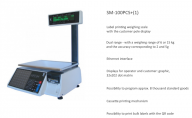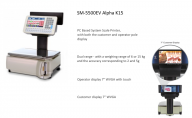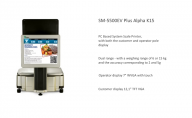The Market program enables automatic cooperation with label printing scales and packaging machines installed in the store. It is possible to automatically send the information about the goods, prices, names, recipes or other data relevant to the weighing system (e.g. the assignment to a specific scales channel) that have changed. By default, the data is sent automatically, but you can manually transfer all data to the selected scales, e.g. when a damaged scales needs to be replaced with a spare one.
In the Market program it is possible to define the configuration of the weighing system, including the scales channels (groups of scales, usually installed at one particular counter, for which the same range of goods is defined), as well as assign scales to certain channels, define the parameters of printed labels, and define masks of scales codes printed by labeling scales.
The numbers for individual goods on the scales (numbers independent of the PLU codes, given on the scales by the seller when weighing a particular product) are managed solely by the program, which always selects the first available one. The program also supports the apiece codes – e.g. at the confectionery part of store where the goods can be weighed, and sold by the piece (e.g. doughnuts), whereas in the latter case the scales prints the code with the number of pieces given by the seller, without the weighing of goods.
New models of DIGI scales, supplied by Forcom, make it possible to identify the cashier and print bulk receipts for the customer. Sellers that serve the customer, provide their ID each time they weigh products (this does not require additional "clicks" on the scales), which results in a print-out of self-adhesive labels for weighed goods. Upon completion of the customer service, the cashier ends the transaction (on any of the scales), which results in printing of the collective transaction code. This code is placed on the bag, which was packed will all of the weighed goods. At the checkout, the collective code in question (QR code) is scanned and all of the goods from the transaction are added to the receipt.
The advantage of this solution is that it is possible to expand the system by adding the analysis of work done by employees working at the stands where the goods are weighted (i.e. the traditional stands), by calculating such parameters as the total time of weighing, the average time of weighing a single commodity, the average service time, the number of serviced customers, the number of weighed goods.







